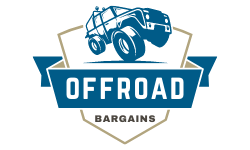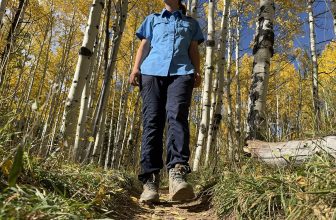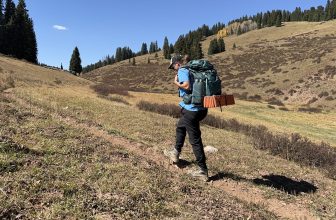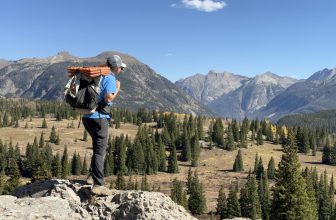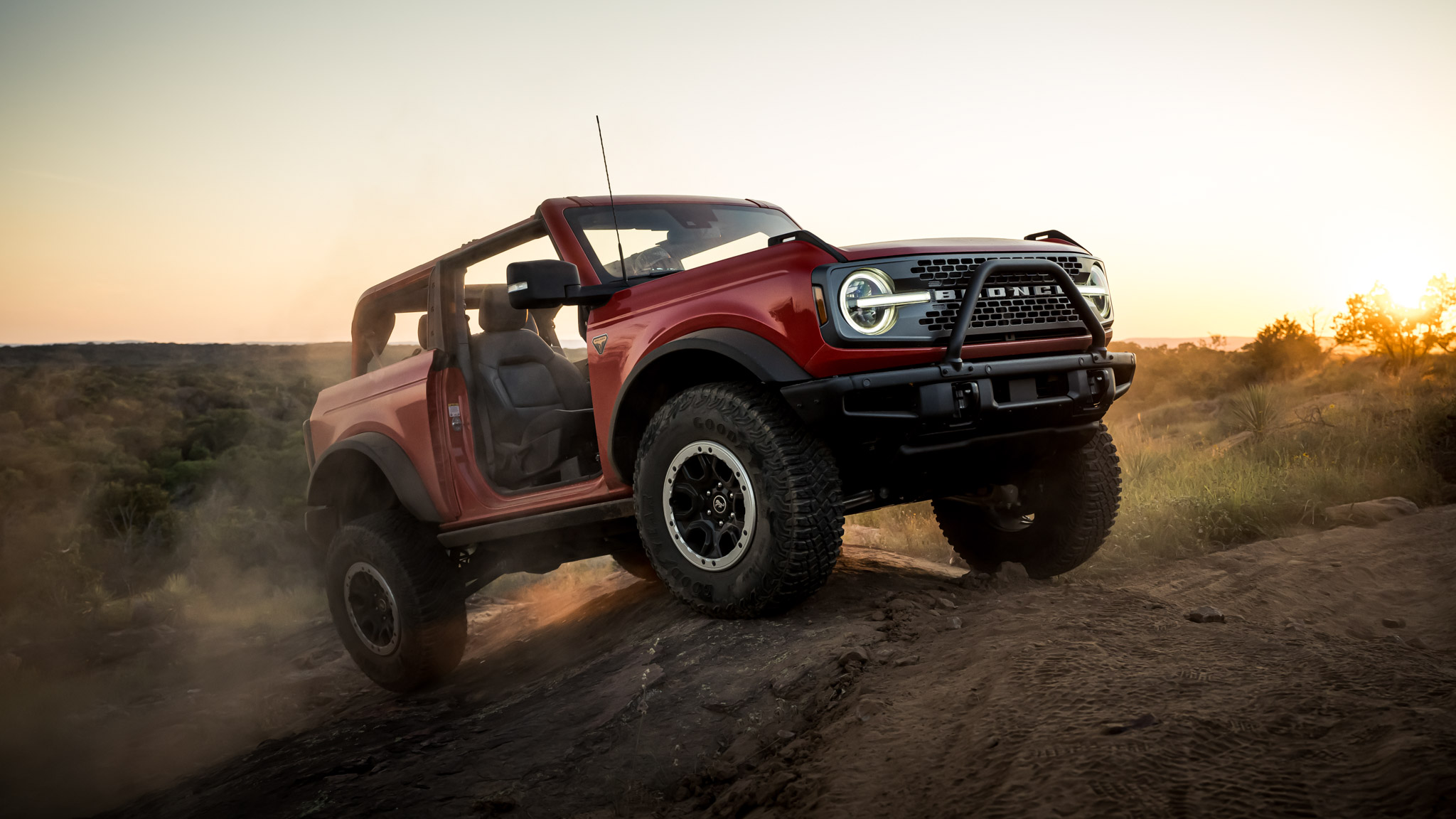
We drive the 2021 Ford Bronco for the first time and find out if it’s a worthy Jeep Wrangler competitor.
The 2021 Bronco is finally here and, if the reception around our first drive location in Austin, Texas, was any indication, highly anticipated. The 2021 Ford Bronco has hit the scene in a way that riding zebraback in our skivvies couldn’t have caused more of an entrance. The last vehicle we drove that drew this much onlooker attention was the Hummer H2 way back in the early 2000s.
We spent a weekend behind the wheel of the Bronco—which was designed and engineered to take on the Jeep Wrangler directly—and feel like we have a pretty good idea of where it excels and where it might fall short. So, is the Bronco going to be the proverbial nail in Jeep’s coffin? Read on to find out.
Based on the next-generation Ford Ranger architecture, the 2021 Ford Bronco has independent front suspension solid axle rear and is available in five trims, two body styles, and with two engine and two transmission options. Like the Wrangler, it is a convertible, with either a hard or soft top, and the doors come off. Unlike its prime competitor, though, the windshield doesn’t fold. To get the breakdown on the Bronco, read our first look article:
We worked with Ford to get a little extra seat time in the new Bronco and were offered a two-door hardtop, in Badlands trim with the 35-inch Sasquatch package, the 330hp and 415-lb-ft-of-torque 2.7L EcoBoost V-6 and 10-speed automatic combo in the Area 51 color. Our well-optioned Bronco had a starting price of $42,095 and added Equipment Group 334A ($5,085), 2.7L EcoBoost ($1,895), Sasquatch Package ($2,495), 10-speed ($1,595), Cargo Area Protector ($120), Towing Capability package ($595), Keyless Entry Keypad ($110), Brush Guard ($300), and Roof Rails with Crossbars ($365). Adding a destination fee of $1,495 brought our as-tested price to $56,150. We were also able to get some additional seat time in a four-dour, 2.3L four-cylinder EcoBoost (300 hp and 325 lb-ft of torque) manual-trans-equipped Wildtrak and a four-door 2.7L Badlands Sasquatch.
First Impressions are that the Bronco feels roomy and open, especially with the halo rollcage that doesn’t have any center bar. Those who are used to Ford materials and control layouts will feel right at home. The major changes are window and mirror controls that are on the front face of the center console, easily falling within reach, and the shifter (in either manual- or automatic-equipped vehicles) right where your hand expects to find it. All the four-wheel drive-centric controls (lockers, sway bar, traction control, Trail Turn Assist, and such.) are mounted high up on the dash pad, while the transfer case shifter and G.O.A.T. (Go Over Any Terrain) Mode selector are housed on the center console. An oversized 12-inch display dominates the dash and really feels gratuitously big for the interior. Seats, covered in water-, UV-, and mold-proof marine-grade vinyl don’t feel cheap or plasticky. Ford Even took the time to place fun Easter eggs all over the Bronco, making for smile-worthy moments as you come across them.
Because Ford decided to go with a longer front door on the two-door model and use a frameless design that allows for easier removal and more compact storage, visibility out the side of the giant windows is exceptional and ingress and egress to the rear seat is surprisingly easy. Thanks to a generous 100.4-inch wheelbase, even the second row has plenty of passenger space for such a short vehicle.
Driving the Bronco is a genuinely enjoyable experience, especially with the roof removed. The view out the windshield is a throwback with that wide, flat hood and the raised-up fender edges, while corner visibility is exceptional thanks to the Trail Sights, which can double as tie downs, on the corners of the hood. Rear visibility isn’t quite as good thanks to the smaller windows and raised beltline behind the front doors. Wind noise is comparable to a Wrangler, and the Goodyear (don’t call them Wrangler) Territory tires give an audible thrum on the highway.
Directional stability, especially on the two-door, is exceptional, with precise steering and rock-solid tracking down the roadway, making easy work of long drives on the highway. The Bilstein shocks are tuned to more of the firm side while still being compliant and comfortable and the Bronco feels good on twisty roads. This is one four-wheel-drive vehicle that can hustle up a mountain road on the way to your favorite wheeling spot without fighting excessive understeer the whole way.
If anything, our biggest beef while driving the Ford is with the gas pedal. If there were ever a vehicle that needed an aftermarket pedal booster, this is the one. It has a wooden, deadened feel to it, ostensibly to improve fuel economy and to make pulling out from stoplights smoother. Switching to “sport” mode helps, but then it changes the transmission shift schedule to stay in the gear and the engine in boost longer. We’d like to see something between normal and sport mode in the normal driving mode with the standard shift schedule. Both engines are too fun and powerful not to let the driver experience their liveliness all the time. Fortunately, the pedal feels good off-road with the powerplants being easy to modulate.
On the topic of off-roading, this is where the Bronco starts to tell the story of Ford’s engineering efforts. We are huge fans of the Sasquatch package with the 35-inch tires and the perfectly tuned Bilstein shocks with the End Stop Control Valves (ESCV), which act as an internal hydraulic bumpstop. Travel is 20 mm shorter than a non-Sasquatch model, but we think it is worth the tradeoff because the control and feel is so good. Until Jeep announced the 35-inch Xtreme Recon package, Ford had all the bragging rights on clearances and angles, which remains excellent at 11.5 inches of ground clearance and approach, breakover, and departure of 43.2/26.3/37 degrees for the four-door Sasquatch and still best-in-class two-door (Jeep’s Xtreme Recon package is four-door only) numbers of 11.6 inches of ground clearance and angles of 43.2/29.0/37.2 degrees.
More of the Bronco off-road goodness continues with a suite of off-road technologies, including up to seven G.O.A.T Modes, depending on the model. Trail Turn Assist brakes the inside rear wheel so the entire vehicle can pivot in place for incredibly tight turns. It is a brilliant execution that only requires a button to be pushed and the wheel at full lock. Another bit of tech is Trail One-Pedal Drive, which, in stealing from the EV market, allows the vehicle to pick through technical terrain with just the gas pedal. We can say it does work well, but we found it too aggressive, essentially braking the vehicle to a full stop instead of allowing it to crawl. This is a great feature for a novice, but seasoned wheelers will appreciate its usage is optional, as is Trail Control, which is like off-road cruise control. The front and rear lockers can be operated independently of one another, and the Bronco also features a hydraulic sway bar disconnect that can operate at any vehicle position—not just when on level ground. Multiple camera views are available to the driver and all of them are crazy good, allowing for spotting from inside the vehicle.
We also found joy in the manual, which has a good clutch feel, despite a long throw. This seven-speed box features an ultra-low 6.588:1 crawler gear that lets Bronco get away with a 2.72:1 or 3.06:1 transfer case, while still delivering a crawl ratio of 94.75:1 on the deeper case and optional 4.7:1 final drive ratio. This is a great option for people who find a 4:1 case too deep and a 2.72:1 case not deep enough.
Despite the Bronco being packed with technology, Ford has done a good job of letting it be secondary to the driving experience. It is there when you want to use it and it’s in the background when you don’t. Simple things, like hard buttons and the extended shelf under the 12-inch display to steady your hand on the touchscreen, make the tech easier to use in a moving vehicle.
Let’s talk about those signature, and somewhat controversial, mirrors and doors. Door removal is a great idea, but in practice, we found the reinstallation process a little cumbersome. Ford designed the Broncos with frameless and mirrorless doors that makes them easier to stow, including in the cargo area of a four-door. Removing the doors is straightforward and Ford uses a single protected Weather Pack-style connector to unplug the door electronics. Because the mirrors stay on the vehicle, users won’t have to add an aftermarket solution to stay road legal. This might be great for most buyers, but for those who wheel on tight forest trails, they will have to take the extra steps of removing the huge mirror housings.
The real fun begins when it’s time to reinstall the doors, which takes some feel and skill since the hinges are hidden in the door jamb and not externally mounted like they are on a Wrangler. During a demonstration, we saw several people struggling to drop the door back on the hinges, including ourselves. It can be a bit frustrating and can even cause damage to the paint if you don’t get it just right. Our suggestion would be to cover the lower corner of the door with some blue painter’s tape the first few times you attempt to reinstall, at least until you get the feel.
There are a few things about the Bronco that we think deserve some criticism. One of them is the stylized instrument cluster that is trying too hard to be cool and makes reading simple information, like the tach, difficult. We also think that while Ford nailed the front design of the Bronco and got the two-door so right, the rear is a bit derivative and the side of the four-door, especially with the hardtop on, is a bit of a hot mess with so many lines and seams coming together in different places. We also found a couple interior issues, from the hard armrest on the door panel that left our leg with an uncomfortable imprint to the non-adjustable front seat belt height that sometimes left the belt digging into our neck. Lastly, we did notice some spare tire and tailgate rattle over high frequency chatter bumps.
By the end of our test, we covered more than 500 miles, got about 15 mpg in mixed driving, and found a reasonable range on the two-door with the 16.9-gallon tank was a little more than 250 miles.
Generally, we walked away very impressed with just how good the Bronco is. The go-fast capability of the IFS was expected, but just how well it flexes and works in the slow stuff was exciting to see. But is this new Bronco a Jeep Wrangler killer? We guess it depends on who you are and what your usage is. For the daily driver, Bronco has the edge in standard power, technology, and steering. We found it similar to the Jeep in ease of use and not terribly different in comfort, amenities, or size. For the person who wants to get the Sasquatch package and leave it, it’s one hell of a fine off-road package that doesn’t need to be messed with. The shocks and chassis, and all the work that went into it, will allow owners to focus on the non-suspension upgrades—it’s that good. It could also be a solid overlanding platform for people who want to carry rooftop cargo, like racks and tents, without drilling into the top.
However, the Bronco is going to be a tougher proposition for those who are looking to go with 38-inch or larger tires, as the required suspension lift could degrade the stellar chassis performance or potentially require dropdown brackets. It will be interesting to see how the aftermarket responds to the need to go big without making the Bronco fullsize in width (for additional travel) or requiring a bunch of additional assemblies (brackets) to make it work. We are sure there are plenty of solid-axle swaps currently under development.
The IFS also has the drawback of making re-gearing more invasive and expensive, and we don’t yet know how all the electronics that are so integrated into the vehicle will react to major modifications. Fortunately, thanks to robust aftermarket partnerships, there will immediately be aftermarket support for Bronco, with hundreds of parts available from major brands.
No matter where you land on the subject, competition is good, and the Bronco deserves to be mentioned in the very same breath as the Wrangler. Whether you prefer one or the other is likely going to come down to your personal use case, and whether you identify with the Ford camp or the Jeep camp. Either way, we can’t wait to welcome Broncos to the trail and see where the platform goes as soon as they get into people’s hands.
2021 Ford Bronco Two-Door Badlands Sasquatch
Base price: $42,095
Engine: 2.7L EcoBoost DOHC twin-turbo DI 60-degree V-6
Rated hp/torque (lb-ft): 330/415
Transmission: 10-speed automatic
4WD system: Two-speed, part-time with automatic on-demand engagement
Low-range ratio: 3.06:1
Frame type: Fully boxed. High-strength steel with seven crossmembers
Suspension, f/r: Twin forged alloy A-arms with coilovers and Bilstein position-sensitive dampers with ESCVs/solid axle with variable-rate coilover springs and Bilstein position-sensitive dampers with ESCVs
Axle ratio: 4.7:1
Max crawl ratio: 67.08:1 (automatic)
Steering: Three-mode rack-and-pinion electric
Brakes, f/r: 12.24×1.33-inch vented discs/12.12×0.94-inch discs
Wheels (in): 17×8.5, beadlock-capable
Tires: 315/70R17 Goodyear Territory
Wheelbase (in): 100.4
Length (in): 174.8
Height (in): 73.8
Width (in): 76.3 (mirrors folded)
Base curb weight (lb): 4,877
Approach/breakover/departure angles (deg): 43.2/29.0/37.2
Minimum ground clearance (in): 11.6
Payload (lb): 982
Max towing capacity (lb): 3,460
Fuel capacity (gal): 16.9
